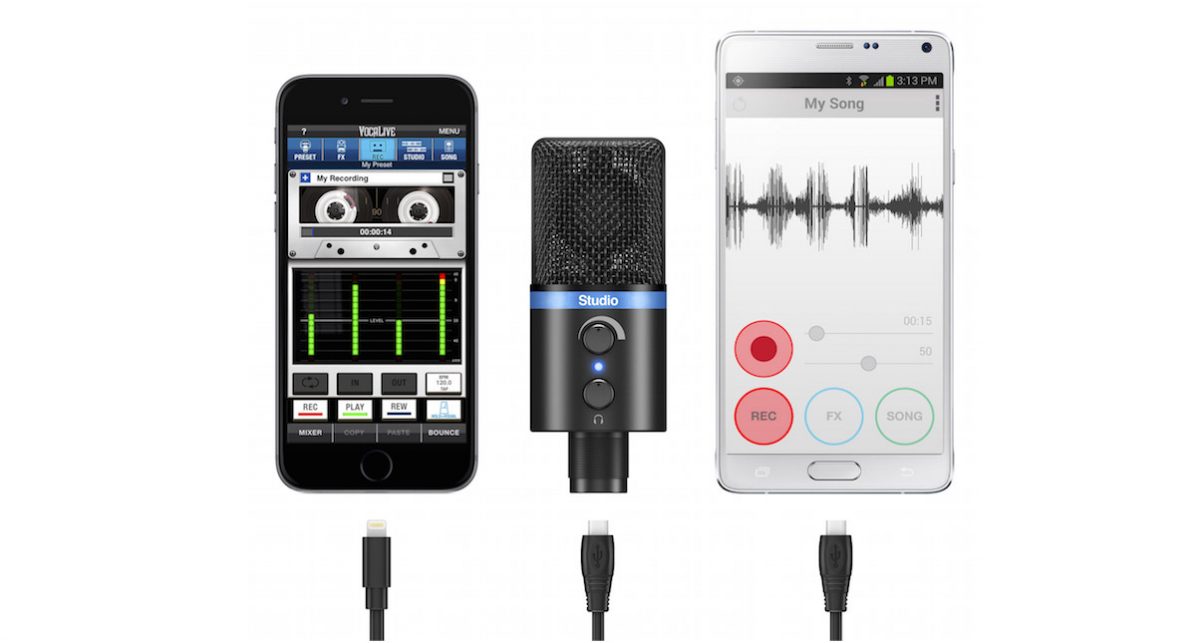The Lowdown
For the kind of “bedroom studio” work we think DJs will want a decent quality mic for, such as podcasting, recording online radio shows, and producing at home, the iRig Studio Mic is perfect.
Video Review
First Impressions / Setting up
We just thought “how neat” when we first saw it. It’s available in black and silver (we are reviewing the black model here), and is a small cylindrical metal mic with a grille protecting a large diaphragm capsule mic.
There are small controls for input and headphone volume, an 1/8″ headphone socket, and a selection of leads for connecting it to iPod/iPad, Android devices, and PC/Mac (the iOS lead is Lightning; you’ll need to buy a 30-pin separately for older models).
The mic comes with a little tabletop tripod stand and a small cloth carry bag that fits the mic itself once unscrewed from the tabletop stand.

In Use
While IK Multimedia supplies some apps for vocal work, recording and so on for use on portable devices, we tested the mic in a scenario most likely to be of use to DJs: recording directly into a computer.
The mic has a built in 24-bit/44.1 & 48 kHz A/D converter so it bypasses any internal converters in your computer etc, and for this test I just plugged it into the USB port on a MacBook, and used Quicktime to record a quick test video/audio recording simply using the built-in camera. In that movie, I tested both the MacBook’s built-in mic and the iRig Studio Mic in order to show the difference between the two. Further than that, I have used it to present DJ coaching webinars to our VIP students.
We found it to be a great little performer. It gives an intimate, full-sounding reproduction, with far less room echo (I have been using it in a very big, boxy room), and is easily good enough for the purposes we suggest DJs will want a mic like this for: Again, radio show recordings (Mixcloud, iTunes podcasts etc), idents and voiceovers / namedrops, and even recording vocals for remixes and own productions, as well as any other sounds your more creative moments demand you to grab and use in your own tunes.
The headphone monitoring is of course useful to have, and the three-way LED on the input control shows you whether you’re too quiet (blue), about right (green), or peaking (orange). The little desktop stand has an adjustable angle and is sturdy, although the feet tips are plastic not rubber, so it will slip easily if touched.

Conclusion
Here at Digital DJ Tips we love small, neat and modern kit that costs a fraction of the price of older stuff it can be used in place of; the kind of kit that allows us to fit into a backpack what might once have taken up a room.
Just like the iPods, laptops, DJ controllers and USB drives we use to replace record collections, full-sized DJ gear and vinyl boxes, this iOS/Android/laptop friendly mic is an example of new technology democratising an aspect of our creativity, and for that we love it.
Of course it isn’t designed to use as a live/club mic (you aren’t meant to plug it straight into a mixer as the audio is internally digitised ready for digital recording, and it would be too delicate anyway), and likewise once you get into full-sized studio situations more “professional” options obviously exist… but for the kind of “bedroom studio” work we thing DJs will want a decent quality mic for, it’s perfect.




